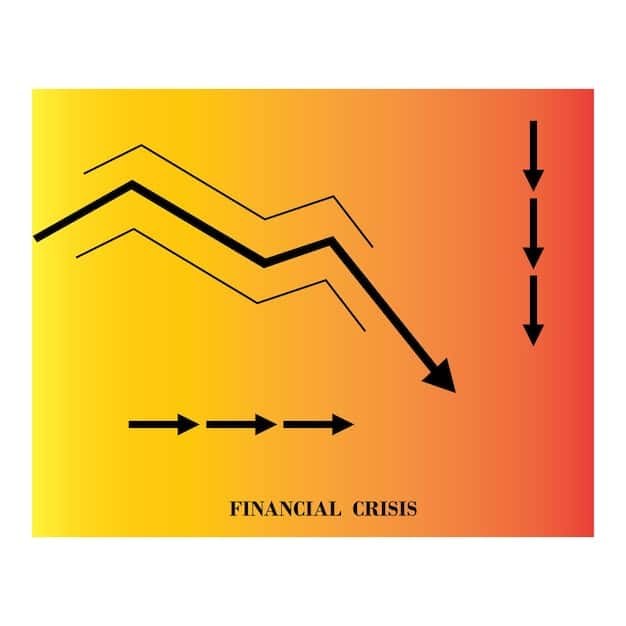Contrarian Investing: Beat the Market in 2025 with Undervalued Stocks

The Contrarian Investor’s Guide to Beating the Market in 2025: Identifying Undervalued Stocks involves strategically opposing prevailing market trends by investing in assets that are currently out of favor but possess strong potential for future growth, requiring thorough research and a willingness to go against the crowd.
Are you tired of following the herd and getting mediocre returns? Want to explore a different path for investing? Then let’s delve into The Contrarian Investor’s Guide to Beating the Market in 2025: Identifying Undervalued Stocks, which could be your roadmap to outperforming the market.
Understanding Contrarian Investing
Contrarian investing is a strategy that goes against the grain of popular market sentiment. It involves identifying assets that are undervalued due to temporary setbacks or negative perceptions, with the expectation that they will eventually recover and offer substantial returns.
Key elements of contrarian investing include:
Identifying Market Sentiment
Understanding the prevailing market sentiment involves recognizing whether investors are generally optimistic (bullish) or pessimistic (bearish). This assessment helps contrarian investors identify potential opportunities where negative sentiment may have driven prices below their intrinsic value.
Valuation Metrics
Contrarian investors often rely on valuation metrics such as price-to-earnings (P/E) ratio, price-to-book (P/B) ratio, and dividend yield to identify undervalued assets. These metrics help determine if a stock is trading below its fair value.
- Price-to-Earnings (P/E) Ratio: Compares a company’s stock price to its earnings per share. A low P/E ratio may indicate undervaluation.
- Price-to-Book (P/B) Ratio: Compares a company’s market capitalization to its book value of equity. A low P/B ratio suggests that the stock may be undervalued relative to its assets.
- Dividend Yield: Measures the dividend income relative to the stock price. A high dividend yield can attract contrarian investors seeking income from undervalued stocks.
Contrarian investing requires a deep understanding of market psychology and the ability to analyze financial data objectively. It’s about making informed decisions rather than following popular trends.

Screening for Undervalued Stocks
Finding undervalued stocks requires a systematic approach. It involves using specific criteria and tools to filter out companies that are trading below their intrinsic value.
Effective methods for screening include:
Using Financial Ratios
Financial ratios are essential tools for contrarian investors. These ratios provide insights into a company’s financial health and valuation, helping to identify potential investment opportunities.
Analyzing Industry Trends
Understanding industry trends is crucial for identifying sectors that are currently out of favor but have the potential for future growth. Contrarian investors look for industries that are facing temporary challenges but have strong fundamentals.
Reviewing Analyst Ratings
While contrarian investors don’t blindly follow analyst ratings, they review them to gauge market sentiment towards a particular stock. If most analysts have negative ratings on a stock, it may be a contrarian opportunity.
Screening for undervalued stocks is not a one-time task but an ongoing process. The market is constantly changing, so contrarian investors need to stay informed and adapt their strategies accordingly.
Remember: Undervalued stocks often come with higher perceived risk, so due diligence is essential.
Assessing Company Fundamentals
A deep dive into company financials is crucial for contrarian investors. It involves scrutinizing financial statements, evaluating management quality, and understanding the company’s competitive position.
Key steps in assessing company fundamentals include:
Analyzing Financial Statements
Reviewing the income statement, balance sheet, and cash flow statement provides a comprehensive understanding of a company’s financial performance. Contrarian investors look for signs of stability and potential for future growth.
Evaluating Management Quality
Assessing the quality of a company’s management team is crucial. Competent and ethical management can navigate challenges and capitalize on opportunities, ultimately driving long-term shareholder value. Contrarian investors look for leaders who have a proven track record and a clear vision for the company’s future.
Understanding Competitive Position
A company’s competitive position within its industry is a key determinant of its long-term success. Contrarian investors look for companies that have a sustainable competitive advantage, such as strong brand recognition, proprietary technology, or a cost advantage.
For example, a company with a strong competitive advantage may be better positioned than its peers to withstand economic downturns and capitalize on emerging opportunities.
Understanding Market Psychology
A strong grasp of market psychology is essential for contrarian investors. It involves understanding how emotions and biases can influence investor behavior and create opportunities for those willing to go against the crowd.
Key aspects of market psychology include:
Fear and Greed
Fear and greed are powerful emotions that drive market cycles. During periods of extreme fear, investors may panic and sell off assets indiscriminately, creating opportunities for contrarian investors to buy at bargain prices.
Herd Mentality
Herd mentality refers to the tendency of investors to follow the crowd, often without conducting thorough research. Contrarian investors seek to avoid herd mentality and make independent decisions based on their own analysis.
Cognitive Biases
Cognitive biases are systematic errors in thinking that can influence investment decisions. Contrarian investors should be aware of these biases and take steps to mitigate their impact. Examples of common cognitive biases include confirmation bias, anchoring bias, and availability bias.
By understanding market psychology and recognizing the influence of emotions and biases, contrarian investors can make more rational and informed decisions.

Strategies for Entering and Exiting Positions
Planning when to enter and exit positions is crucial for contrarian investors. It requires discipline, patience, and a clear understanding of the company’s prospects and market conditions.
Effective strategies include:
Dollar-Cost Averaging
Dollar-cost averaging involves investing a fixed amount of money at regular intervals, regardless of the stock price. This strategy can help reduce the risk of buying at the top and allows investors to accumulate shares over time.
Setting Price Targets
Setting price targets involves establishing a target price at which you plan to sell your shares. This helps to remove emotion from the decision-making process and ensures that you take profits when the stock reaches its fair value.
Using Stop-Loss Orders
A stop-loss order is an order to sell a stock when it reaches a specific price. This helps to limit potential losses and protect your capital. Contrarian investors use stop-loss orders selectively, as they don’t want to be shaken out of a position prematurely.
For example, if a stock price declines significantly after you invest, a stop-loss order can help minimize your losses. However, it’s important to set the stop-loss order at a level that is not too close to the current price, to avoid being triggered by normal market fluctuations.
Risk Management in Contrarian Investing
Managing risk is essential for contrarian investors. It involves understanding the potential downsides of an investment and taking steps to mitigate those risks.
Key risk management techniques include:
Diversification
Diversification involves spreading your investments across a variety of different stocks, industries, and asset classes. This reduces the risk of being overly exposed to any single investment.
Position Sizing
Position sizing involves determining the appropriate amount of capital to allocate to each investment. Contrarian investors often allocate a smaller portion of their portfolio to higher-risk, undervalued stocks.
Due Diligence
Thorough due diligence involves conducting extensive research on a company before investing. This includes analyzing financial statements, evaluating management quality, and understanding the company’s competitive position.
By effectively managing risk, contrarian investors can protect their capital and increase their chances of long-term success.
Contrarian investing is not for the faint of heart. It requires courage, conviction, and a willingness to go against the prevailing market sentiment.
| Key Point | Brief Description |
|---|---|
| 💡 Identify Undervalued Stocks | Look for companies with low P/E or P/B ratios. |
| 📊 Analyze Financials | Review income statements, balance sheets, and cash flow. |
| ⚖️ Manage Risks | Diversify portfolio and use stop-loss orders. |
| 🧠 Understand Market Psychology | Be aware of herd mentality and cognitive biases. |
FAQ
Contrarian investing involves going against the prevailing market sentiment by investing in assets that are currently out of favor. It’s about buying when others are selling and selling when others are buying.
You can find undervalued stocks by using financial ratios like the P/E and P/B ratios, analyzing industry trends, and reviewing analyst ratings. Look for companies with strong fundamentals but negative market sentiment.
The risks of contrarian investing include the possibility that the market’s negative sentiment is justified and the stock may not recover. It’s also possible that it might take longer than you expect for the market to recognize the value.
Risk management is crucial. Diversify your portfolio, use position sizing to allocate capital, and conduct thorough due diligence before investing. Stop-loss orders can help limit potential losses.
Market psychology is very important. Understand how emotions like fear and greed can influence investor behavior and create opportunities. Avoid herd mentality and be aware of cognitive biases.
Conclusion
In conclusion, The Contrarian Investor’s Guide to Beating the Market in 2025: Identifying Undervalued Stocks offers a unique approach to investment. By understanding market psychology, assessing company fundamentals, and managing risks effectively, investors can potentially generate significant returns by capitalizing on undervalued opportunities.





